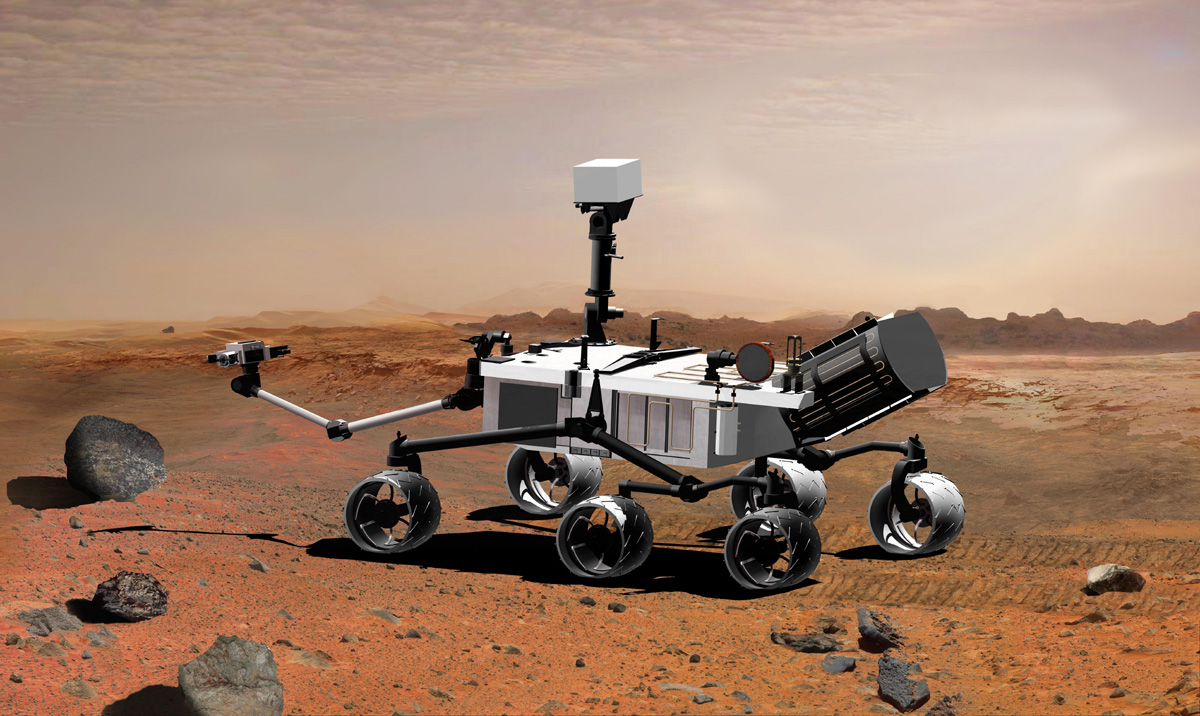[/caption]
The Mars Science Laboratory, the next generation of Mars rovers slated to head to Mars in 2009, is still alive, for the time being. The car-sized rover designed to look for life on Mars is over budget and behind schedule due to technical problems, and NASA officials met today to discuss their options. Potentially, Congress could pull the plug on the mission if cost overruns go too high. NASA Administrator Mike Griffin and Science Associate Administrator Ed Weiler were briefed, and met with mission managers in attempt to work out a potential solution. In a press briefing today, Doug McCuistion, director of the Mars Exploration Program at NASA headquarters said the rover’s progress will be assessed again in January, but the mission will need more money. “This is a really important scientific mission,” McCuistion said. “This is truly the push into the next decade for the Mars program and for the discovery for the potential for life on other planets…I fully believe that Congress will support us as we go forward on this because they recognize the importance of the mission as well.”
The panel of NASA officials at the briefing wouldn’t say where the money will come from or exactly how much will be needed to keep the rover on schedule and provide the engineers the resources they need to overcome the technical problems. But NASA will seek additional money from Congress and/or realign funds from other missions.
“If we’re going to launch in 2009 or 2011 additional budget resources are going to be necessary. The sources of that we cannot release until we get approval from the Office of Management and Budget and Congress,” said McCuistion.
Costs for MSL have already gone from the initial $1.5 billion to $1.9 billion. Launch is scheduled sometime between Sept. 15 and Oct. 15, 2009, but could be delayed until 2011 if the problems take more time to be resolved. Earth and Mars come closest to each other approximately every 26 months, providing favorable launch windows.
Problems with parachutes, actuators and other materials have delayed construction of the rover, and currently the contractors are working multiple shifts to make up for lost time. Mission managers hope tests of the rover can begin in November or December.
MSL will be three times as heavy and twice the width of the Mars Exploration Rovers (MERs) that landed in 2004, and will be able to travel twice as far. It will carry ten advanced scientific instruments and cameras. It will make the first precise landing and a predetermined site, using a guided entry system and a soft-landing system called the Sky Crane.
Source: NASA News Audio


That is why it is so important to stimulate the general public imagination with more than scientific endeavors. The public need speculations, clearer pictures, questionable subject images, more “faces”, more pyramids, anything that pull enthusiasm out your regular joe.
I will back any NASA plans. I think it is very important for humanity to get on the wagon of space exploration. But NASA cannot continue to push forward a dull public relation with half answers, uncertain conclusions and apparent denial of good answers about some unexplainable Martian structure. No more balloon explanations. Tickle the fancy of the public. They are the one who can stops cuts in space exploration.
I have a really hard time understanding why more than a billion dollars were spent for the Polar Lander- whose mission is nearly over due to RTG depletion. The use of pricey non-rovers is inexplicable. And now we find our selves a bit short for this superior project. Go figure.
Funny, I had always thought that just sending more of the successful MERs, with more modern & only slightly heavier instruments, keeping to using solar panels/batteries (again modern ones are better & hence can be smaller) would have been a better and cheaper idea. The MSL uses RTGs which are way more expensive than solar – there have also been a chronic shortage of plutonium 238, using it for the MSL impacts future outer planet missions where RTGs are essential. Heck, just keep building MERs & send one every 2 years, you can evolve/use the same infrastrucure & operators & get costs down..
NASA is very good at doing its most successful designs only a few times, then throwing out all the “tried and tested” tech, and starting again – think Apollo->Shuttle..
(@Michael: I assume you mean Phoenix – it uses Solar, and at the poles you soon have 24 hours darkness. Its been a “cheap” mission, at around $400 million..)